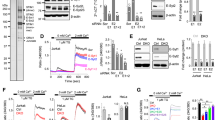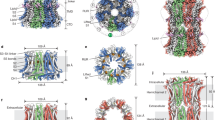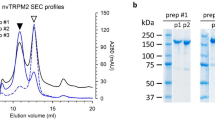Abstract
Store-operated Ca2+ entry through the plasma membrane Ca2+ release–activated Ca2+ (CRAC) channel in mammalian T cells and mast cells depends on the sensor protein stromal interaction molecule 1 (STIM1) and the channel subunit ORAI1. To study STIM1-ORAI1 signaling in vitro, we have expressed human ORAI1 in a sec6-4 strain of the yeast Saccharomyces cerevisiae and isolated sealed membrane vesicles carrying ORAI1 from the Golgi compartment to the plasma membrane. We show by in vitro Ca2+ flux assays that bacterially expressed recombinant STIM1 opens wild-type ORAI1 channels but not channels assembled from the ORAI1 pore mutant E106Q or the ORAI1 severe combined immunodeficiency (SCID) mutant R91W. These experiments show that the STIM1-ORAI1 interaction is sufficient to gate recombinant human ORAI1 channels in the absence of other proteins of the human ORAI1 channel complex, and they set the stage for further biochemical and biophysical dissection of ORAI1 channel gating.
This is a preview of subscription content, access via your institution
Access options
Subscribe to this journal
Receive 12 print issues and online access
$189.00 per year
only $15.75 per issue
Buy this article
- Purchase on Springer Link
- Instant access to full article PDF
Prices may be subject to local taxes which are calculated during checkout




Similar content being viewed by others
References
Feske, S. Calcium signalling in lymphocyte activation and disease. Nat. Rev. Immunol. 7, 690–702 (2007).
Oh-hora, M. & Rao, A. Calcium signaling in lymphocytes. Curr. Opin. Immunol. 20, 250–258 (2008).
Baba, Y. et al. Essential function for the calcium sensor STIM1 in mast cell activation and anaphylactic responses. Nat. Immunol. 9, 81–88 (2008).
Vig, M. et al. Defective mast cell effector functions in mice lacking the CRACM1 pore subunit of store-operated calcium release-activated calcium channels. Nat. Immunol. 9, 89–96 (2008).
Parekh, A.B. & Putney, J.W. Jr. Store-operated calcium channels. Physiol. Rev. 85, 757–810 (2005).
Putney, J.W. Jr. Recent breakthroughs in the molecular mechanism of capacitative calcium entry (with thoughts on how we got here). Cell Calcium 42, 103–110 (2007).
Hogan, P.G. & Rao, A. Dissecting ICRAC, a store-operated calcium current. Trends Biochem. Sci. 32, 235–245 (2007).
Roos, J. et al. STIM1, an essential and conserved component of store-operated Ca2+ channel function. J. Cell Biol. 169, 435–445 (2005).
Liou, J. et al. STIM is a Ca2+ sensor essential for Ca2+ store depletion–triggered Ca2+ influx. Curr. Biol. 15, 1235–1241 (2005).
Zhang, S.L. et al. STIM1 is a Ca2+ sensor that activates CRAC channels and migrates from the Ca2+ store to the plasma membrane. Nature 437, 902–905 (2005).
Feske, S. et al. A mutation in Orai1 causes immune deficiency by abrogating CRAC channel function. Nature 441, 179–185 (2006).
Zhang, S.L. et al. Genome-wide RNAi screen of Ca2+ influx identifies genes that regulate Ca2+ release-activated Ca2+ channel activity. Proc. Natl. Acad. Sci. USA 103, 9357–9362 (2006).
Vig, M. et al. CRACM1 is a plasma membrane protein essential for store-operated Ca2+ entry. Science 312, 1220–1223 (2006).
Yeromin, A.V. et al. Molecular identification of the CRAC channel by altered ion selectivity in a mutant of Orai. Nature 443, 226–229 (2006).
Prakriya, M. et al. Orai1 is an essential pore subunit of the CRAC channel. Nature 443, 230–233 (2006).
Vig, M. et al. CRACM1 multimers form the ion-selective pore of the CRAC channel. Curr. Biol. 16, 2073–2079 (2006).
Spassova, M.A. et al. STIM1 has a plasma membrane role in the activation of tore-operated Ca2+ channels. Proc. Natl. Acad. Sci. USA 103, 4040–4045 (2006).
Mercer, J.C. et al. Large store-operated calcium selective currents due to co-expression of Orai1 or Orai2 with the intracellular calcium sensor, Stim1. J. Biol. Chem. 281, 24979–24990 (2006).
Wu, M.M., Buchanan, J., Luik, R.M. & Lewis, R.S. Ca2+ store depletion causes STIM1 to accumulate in ER regions closely associated with the plasma membrane. J. Cell Biol. 174, 803–813 (2006).
Baba, Y. et al. Coupling of STIM1 to store-operated Ca2+ entry through its constitutive and inducible movement in the endoplasmic reticulum. Proc. Natl. Acad. Sci. USA 103, 16704–16709 (2006).
Liou, J., Fivaz, M., Inoue, T. & Meyer, T. Live-cell imaging reveals sequential oligomerization and local plasma membrane targeting of stromal interaction molecule 1 after Ca2+ store depletion. Proc. Natl. Acad. Sci. USA 104, 9301–9306 (2007).
Ong, H.L. et al. Relocalization of STIM1 for activation of store-operated Ca2+ entry is determined by the depletion of subplasma membrane endoplasmic reticulum Ca2+ store. J. Biol. Chem. 282, 12176–12185 (2007).
Xu, P. et al. Aggregation of STIM1 underneath the plasma membrane induces clustering of Orai1. Biochem. Biophys. Res. Commun. 350, 969–976 (2006).
Luik, R.M., Wu, M.M., Buchanan, J. & Lewis, R.S. The elementary unit of store-operated Ca2+ entry: local activation of CRAC channels by STIM1 at ER-plasma membrane junctions. J. Cell Biol. 174, 815–825 (2006).
Luik, R.M., Wang, B., Prakriya, M., Wu, M.M. & Lewis, R.S. Oligomerization of STIM1 couples ER calcium depletion to CRAC channel activation. Nature 454, 538–542 (2008).
Muik, M. et al. Dynamic coupling of the putative coiled-coil domain of ORAI1 with STIM1 mediates ORAI1 channel activation. J. Biol. Chem. 283, 8014–8022 (2008).
Navarro-Borelly, L. et al. STIM1-Orai1 interactions and Orai1 conformational changes revealed by live-cell FRET microscopy. J. Physiol. (Lond.) 586, 5383–5401 (2008).
Stathopulos, P.B., Li, G.Y., Plevin, M.J., Ames, J.B. & Ikura, M. Stored Ca2+ depletion-induced oligomerization of stromal interaction molecule 1 (STIM1) via the EF-SAM region: an initiation mechanism for capacitive Ca2+ entry. J. Biol. Chem. 281, 35855–35862 (2006).
Stathopulos, P.B., Zheng, L., Li, G.Y., Plevin, M.J. & Ikura, M. Structural and mechanistic insights into STIM1-mediated initiation of store-operated calcium entry. Cell 135, 110–122 (2008).
Várnai, P., Tóth, B., Tóth, D.J., Hunyady, L. & Balla, T. Visualization and manipulation of plasma membrane-endoplasmic reticulum contact sites indicates the presence of additional molecular components within the STIM1-Orai1 complex. J. Biol. Chem. 282, 29678–29690 (2007).
Peinelt, C. et al. Amplification of CRAC current by STIM1 and CRACM1 (Orai1). Nat. Cell Biol. 8, 771–773 (2006).
Soboloff, J. et al. Orai1 and STIM reconstitute store-operated calcium channel function. J. Biol. Chem. 281, 20661–20665 (2006).
Strayle, J., Pozzan, T. & Rudolph, H.K. Steady-state free Ca2+ in the yeast endoplasmic reticulum reaches only 10 μM and is mainly controlled by the secretory pathway pump Pmr1. EMBO J. 18, 4733–4743 (1999).
Locke, E.G., Bonilla, M., Liang, L., Takita, Y. & Cunningham, K.W. A homolog of voltage-gated Ca2+ channels stimulated by depletion of secretory Ca2+ in yeast. Mol. Cell. Biol. 20, 6686–6694 (2000).
Silverman-Gavrila, L.B. & Lew, R.R. An IP3-activated Ca2+ channel regulates fungal tip growth. J. Cell Sci. 115, 5013–5025 (2002).
Novick, P., Field, C. & Schekman, R. Identification of 23 complementation groups required for post-translational events in the yeast secretory pathway. Cell 21, 205–215 (1980).
TerBush, D.R., Maurice, T., Roth, D. & Novick, P. The Exocyst is a multiprotein complex required for exocytosis in Saccharomyces cerevisiae. EMBO J. 15, 6483–6494 (1996).
Nakamoto, R.K., Rao, R. & Slayman, C.W. Expression of the yeast plasma membrane [H+]ATPase in secretory vesicles. A new strategy for directed mutagenesis. J. Biol. Chem. 266, 7940–7949 (1991).
Ruetz, S. & Gros, P. Phosphatidylcholine translocase: a physiological role for the mdr2 gene. Cell 77, 1071–1081 (1994).
Laizé, V. et al. Functional expression of the human CHIP28 water channel in a yeast secretory mutant. FEBS Lett. 373, 269–274 (1995).
Coury, L.A. et al. Reconstitution of water channel function of aquaporins 1 and 2 by expression in yeast secretory vesicles. Am. J. Physiol. 274, F34–F42 (1998).
Huang, G.N. et al. STIM1 carboxyl-terminus activates native SOC, Icrac and TRPC1 channels. Nat. Cell Biol. 8, 1003–1010 (2006).
Zhang, S.L. et al. Store-dependent and -independent modes regulating Ca2+ release-activated Ca2+ channel activity of human Orai1 and Orai3. J. Biol. Chem. 283, 17662–17671 (2008).
Penna, A. et al. The CRAC channel consists of a tetramer formed by Stim-induced dimerization of Orai dimers. Nature 456, 116–120 (2008).
Ji, W. et al. Functional stoichiometry of the unitary calcium-release-activated calcium channel. Proc. Natl. Acad. Sci. USA 105, 13668–13673 (2008).
Li, Z. et al. Mapping the interacting domains of STIM1 and Orai1 in Ca2+ release-activated Ca2+ channel activation. J. Biol. Chem. 282, 29448–29456 (2007).
Park, C.Y. et al. STIM1 clusters and activates CRAC channels via direct binding of a cytosolic domain to Orai1. Cell 136, 876–890 (2009).
Derler, I. et al. Increased hydrophobicity at the N terminus/membrane interface impairs gating of the severe combined immunodeficiency-related ORAI1 mutant. J. Biol. Chem. 284, 15903–15915 (2009).
Meyer, T., Wensel, T. & Stryer, L. Kinetics of calcium channel opening by inositol 1,4,5-trisphosphate. Biochemistry 29, 32–37 (1990).
Palmer, A.E. et al. Ca2+ indicators based on computationally redesigned calmodulin-peptide pairs. Chem. Biol. 13, 521–530 (2006).
Yuan, J.P. et al. SOAR and the polybasic STIM1 domains gate and regulate Orai channels. Nat. Cell Biol. 11, 337–343 (2009).
Muik, M. et al. A cytosolic homomerization and a modulatory domain within STIM1 C terminus determine coupling to ORAI1 channels. J. Biol. Chem. 284, 8421–8426 (2009).
Kawasaki, T., Lange, I. & Feske, S. A minimal regulatory domain in the C terminus of STIM1 binds to and activates ORAI1 CRAC channels. Biochem. Biophys. Res. Commun. 385, 49–54 (2009).
Miller, C.A. III, Martinat, M.A. & Hyman, L.E. Assessment of aryl hydrocarbon receptor complex interactions using pBEVY plasmids: expression vectors with bi-directional promoters for use in Saccharomyces cerevisiae. Nucleic Acids Res. 26, 3577–3583 (1998).
Bitter, G.A., Chen, K.K., Banks, A.R. & Lai, P.H. Secretion of foreign proteins from Saccharomyces cerevisiae directed by α-factor gene fusions. Proc. Natl. Acad. Sci. USA 81, 5330–5334 (1984).
Whitmore, L. & Wallace, B.A. DICHROWEB, an online server for protein secondary structure analyses from circular dichroism spectroscopic data. Nucleic Acids Res. 32, W668–W673 (2004).
Coury, L.A., Zeidel, M.L. & Brodsky, J.L. Use of yeast sec6 mutant for purification of vesicles containing recombinant membrane proteins. Methods Enzymol. 306, 169–186 (1999).
Oh-hora, M. et al. Dual functions for the endoplasmic reticulum calcium sensors STIM1 and STIM2 in T cell activation and tolerance. Nat. Immunol. 9, 432–443 (2008).
Ansel, K.M. et al. Deletion of a conserved Il4 silencer impairs T helper type 1-mediated immunity. Nat. Immunol. 5, 1251–1259 (2004).
Acknowledgements
We are grateful to H. Li for guidance on protein expression and purification. We thank R. Rao for S. cerevisiae strain NY17 and for advice on membrane protein expression in that sec6-4 strain, R.Y. Tsien for plasmids encoding the calcium sensors D3cpV and D4cpV, J. Cregg for advice on protein expression in P. pastoris, the Department of Neurobiology, Harvard Medical School, for use of their spectrofluorimeter and T. Rapoport for access to SEC-MALLS instrumentation. This work was supported by US National Institutes of Health grants AI40127, GM075256 and AI084167 (to A.R. and P.G.H.) and by an Irvington Fellowship from the Cancer Research Institute and a Postdoctoral Fellowship from the Leukemia and Lymphoma Society (to Y.Z.).
Author information
Authors and Affiliations
Contributions
P.G.H. set overall goals for the project and coordinated the work; Y.Z., P.M., A.R. and P.G.H. designed experiments and wrote the manuscript; Y.Z. prepared and characterized the STIM1 reagents, measured STIM-ORAI interactions and conducted the assays using mammalian cells; P.M. prepared and characterized sec6-4 ORAI1 vesicles; Y.Z. and P.M. conducted the in vitro Ca2+ flux assays; D.M. and H.T.K. developed the P. pastoris membrane-flotation assay; M.O., with Y.Z., carried out reconstitution and Ca2+-imaging experiments using STIM1−/− T cells; J.Z., with Y.Z., carried out SEC-MALLS analyses; Y.H., with Y.Z., contributed confocal microscopy; A.S. helped P.M. with construction of S. cerevisiae expression plasmids.
Corresponding author
Ethics declarations
Competing interests
A.R. and P.G.H. are founders and scientific advisors to CalciMedica, Inc., a biotechnology company developing treatments for autoimmune and inflammatory diseases.
Supplementary information
Supplementary Text and Figures
Supplementary Figures 1–5, Supplementary Data and Supplementary Methods (PDF 880 kb)
Rights and permissions
About this article
Cite this article
Zhou, Y., Meraner, P., Kwon, H. et al. STIM1 gates the store-operated calcium channel ORAI1 in vitro. Nat Struct Mol Biol 17, 112–116 (2010). https://doi.org/10.1038/nsmb.1724
Received:
Accepted:
Published:
Issue Date:
DOI: https://doi.org/10.1038/nsmb.1724
This article is cited by
-
NNAT is a novel mediator of oxidative stress that suppresses ER + breast cancer
Molecular Medicine (2023)
-
Paraquat is an agonist of STIM1 and increases intracellular calcium levels
Communications Biology (2022)
-
Cortisol modulates calcium release-activated calcium channel gating in fish hepatocytes
Scientific Reports (2021)
-
Circularly permuted LOV2 as a modular photoswitch for optogenetic engineering
Nature Chemical Biology (2021)
-
TRPP2 and STIM1 form a microdomain to regulate store-operated Ca2+ entry and blood vessel tone
Cell Communication and Signaling (2020)



